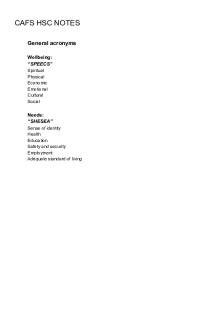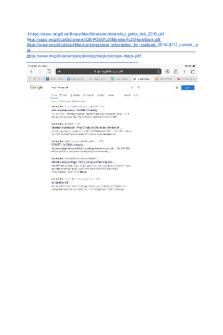Print Cafs Prelim notes for school year 11 PDF

| Title | Print Cafs Prelim notes for school year 11 |
|---|---|
| Author | Azy Holland |
| Course | Family and Community Contexts of Early Childhood |
| Institution | Macquarie University |
| Pages | 2 |
| File Size | 60 KB |
| File Type | |
| Total Downloads | 25 |
| Total Views | 144 |
Summary
this is a summray for year 11 students doing prelims which can help with communities and families...
Description
SHE SEAS S - Safety and security H - Health E-Education S - A sense of identity E - Employment A - Adequate S - The standard of living
SPEECS S- Social P- Physical E- Emotional E- Economic C- Cultural S- Spiritual
FROCESS F- Family + Friends R- Religious O- Other C- culture S- Sport + Leisure S- School + Work
Social G- Gender R- Relationships A- Attitudes of group members M- Media
Personal C- Cultural H- Heridital E-Education E- Employment P- Previous experience SS- Self Esteem S-
Norms, Conformity and Cohesiveness Relationships between group members are greatly dependent on the norms, conformity and cohesiveness within the group. These also influence how tasks are performed and the effectiveness of the group. Norms- A standard or pattern of behaviour that is considered normal in a particular society. Norms are implicit, specific rules, shared by a group of individuals, that guide their interactions with others. Norms dictate the actions of group members. Groups tend to benefit from having mutually acceptable norms as they bring regularity and control to relationships. All groups have norms, set informally or formally. Examples of norms going to school, being respectful, using manners, taking turns in class, sticking to the left on an escalator and make sure not to listen whilst others are talking. Conformity- is the act of matching attitudes, beliefs, and behaviours to group norms. When an individual joins a group they may feel the need to change to “fit in”. Failure to do so may result in rejection or isolation. In order to remain in a group, a member must conform to group norms. Blindly following orders might be negative but it is also has a positive impact on individuals’ wellbeing. Self Leadership and leadership styles Manage time (Self Leadership), How well you achieve the task (Self Leadership), Influence others (Leadership Styles), Taking Responsibility for others (Leadership styles), Taking Responsibility for your own actions (Self Leadership), How you influence yourself and how you think (Self Leadership), Self-control (Self Leadership), Expectationships (Self Leadership), Resilience ( Self Leadership), Expectation (Leadership styles) and Manage Time (Self Leadership) Leadership Styles Automatic, Democratic, Transformational and Laissez-Faire -
-
The family can be defined in terms of its structure and the tasks it performs. Family structures evident in Australia today include adoptive, blended, childless, communal, de facto, extended, foster, nuclear, same-sex couples, sole-parent and kinship. The family has a variety of functions to perform in order to satisfy members' needs. These include physical, economic, emotional, social, cultural, moral and adaptive functions. Communities are characterised by individuals becoming involved in a variety of groups in order to achieve common goals and gain a sense of identity. Community groups form due to geographic reasons, shared interests or other reasons. Community is organised on local, state, national and global levels. At each level members of the community undertake roles, have influence and make decisions. Communities undergo change as a result of work and employment patterns, trauma or crisis, or demographics. The impacts of such changes can be positive and negative. Decision-making in groups is a process that may involve arbitration, consensus, election or voting, or referendum. Individuals and groups play a role in influencing decisions by means of legislation, environmental pressures, lobbying or protesting. Families undergo many changes, including internal and external, planned and unplanned, temporary and permanent, and all these impacts roles within the family. Formal and informal support networks are available to families within the community. Individuals pass through stages of the lifespan: pregnancy, infancy, childhood, adolescence, young and middle adulthood and old age. At each stage, various physical, intellectual, emotional, social, cultural and spiritual needs will be significant. Socialisation involves learning the accepted behaviours of society so as to be an effective and productive member of that society. It occurs through primary and secondary groups....
Similar Free PDFs

Prelim Notes Year 11 Legal
- 3 Pages

Prelim CAFS Notes - Grade: A
- 23 Pages

Modules for school year 2020/2021
- 44 Pages

Pdhpe Notes preliminary year 11
- 69 Pages

CAFS Study Notes Homeless
- 10 Pages

CAFS HSC Notes - Youth
- 6 Pages

CAFS HSC Notes
- 33 Pages

Term 1 Year 11 Economic Notes
- 18 Pages
Popular Institutions
- Tinajero National High School - Annex
- Politeknik Caltex Riau
- Yokohama City University
- SGT University
- University of Al-Qadisiyah
- Divine Word College of Vigan
- Techniek College Rotterdam
- Universidade de Santiago
- Universiti Teknologi MARA Cawangan Johor Kampus Pasir Gudang
- Poltekkes Kemenkes Yogyakarta
- Baguio City National High School
- Colegio san marcos
- preparatoria uno
- Centro de Bachillerato Tecnológico Industrial y de Servicios No. 107
- Dalian Maritime University
- Quang Trung Secondary School
- Colegio Tecnológico en Informática
- Corporación Regional de Educación Superior
- Grupo CEDVA
- Dar Al Uloom University
- Centro de Estudios Preuniversitarios de la Universidad Nacional de Ingeniería
- 上智大学
- Aakash International School, Nuna Majara
- San Felipe Neri Catholic School
- Kang Chiao International School - New Taipei City
- Misamis Occidental National High School
- Institución Educativa Escuela Normal Juan Ladrilleros
- Kolehiyo ng Pantukan
- Batanes State College
- Instituto Continental
- Sekolah Menengah Kejuruan Kesehatan Kaltara (Tarakan)
- Colegio de La Inmaculada Concepcion - Cebu







